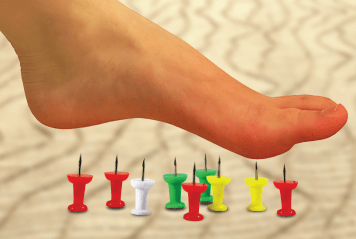
Diagnosed with Cancer? Your two greatest challenges are understanding cancer and understanding possible side effects from chemo and radiation. Knowledge is Power!
Learn about conventional, complementary, and integrative therapies.
Dealing with treatment side effects? Learn about evidence-based therapies to alleviate your symptoms.
Click the orange button to the right to learn more.
- You are here:
- Home »
- Blog »
- side effects ID and prevention »
- CIPN Breakthrough?
CIPN Breakthrough?

Chemotherapy-induced peripheral neuropathy (CIPN) is one of the most common (30%-60%) and potentially painful long-term side effects there is. The percentage of cancer patients varies because some cancer patients develop CIPN during therapy only to have this side effect resolve itself when treatment stops.
I am a long-term cancer survivor living with a number of long-term side effects. Fortunately my nerve damage exhibits itself through numbness not pain.
I have blogged repeatedly about CIPN and possible therapies. I have never known of a therapy to completely elivate CIPN pain consistently for all cancer survivors who suffer from this debilitating side effect.
For this reason, I encourage anyone who suffers from CIPN to read the linked post in an effort to learn about possible CIPN therapies and then try multiple therapies in hopes of treating your nerve pain.
- Chemotherapy-Induced Peripheral Neuropathy
- Home Remedies for Neuropathy from Chemo aka CIPN
- Myeloma – Chemotherapy-Induced Peripheral Neuropathy
What therapies help manage chemotherapy-induced peripheral neuropathy?
- Medications:
- Antidepressants: Certain antidepressant medications, such as duloxetine, may help manage neuropathic pain.
- Anticonvulsants: Medications like gabapentin or pregabalin may be prescribed to alleviate nerve pain.
- Physical Therapy:
- Physical therapy exercises and techniques may help improve muscle strength, balance, and coordination, reducing the impact of neuropathy symptoms.
- Acupuncture:
- Acupuncture has been explored as a complementary therapy for managing neuropathy symptoms. Some people find relief through acupuncture sessions.
- Nutritional Supplements:
- Supplementation with certain vitamins and minerals, such as vitamin B12, may be recommended to support nerve health.
- Topical Treatments:
- Creams or patches containing certain medications, such as capsaicin or lidocaine, may be applied topically to relieve localized pain.
- Lifestyle Modifications:
- Maintaining a healthy lifestyle, including regular exercise and a balanced diet, may contribute to overall well-being and potentially alleviate some symptoms.
Are you a cancer survivor? What long-term side effects, beside CIPN, are you managing? Let me know-
David.PeopleBeatingCancer@gmail.com
hang in there,
David Emerson
- Cancer Survivor
- Cancer Coach
- Director PeopleBeatingCancer
Wireless Transcutaneous Electrical Nerve Stimulation (TENS) for Chronic Chemotherapy-Induced Peripheral Neuropathy (CIPN): A Proof-of-Concept Randomized Clinical Trial
“Chemotherapy-induced peripheral neuropathy (CIPN) affects approximately 30 to 60% of people who receive neurotoxic chemotherapy. CIPN is associated with impaired quality of life and function and has few effective treatments.
This 6-site, subject and assessor-blinded randomized clinical trial (RCT) was designed to assess
1) preliminary efficacy (ie, alpha pre-specified at .2) of a wearable, app-controlled, transcutaneous electrical nerve stimulation (TENS) device for chronic CIPN and
2) feasibility of conducting a confirmatory trial within the National Cancer Institute Community Oncology Research Program (NCORP) (NCT 04367480).
The primary outcome was the EORTC-CIPN20. The main secondary outcomes were individual symptoms assessed daily (via 0–10 numeric rating scales). The primary analysis was an analysis of covariance (outcome: EORTC-CIPN20, fixed effect: arm, covariates: baseline EORTC-CIPN20 and site).
Secondary analyses used a similar analysis of covariance models (excluding site) for each symptom on subgroups of subjects with ≥4 out of 10 for that symptom at baseline.
142 eligible subjects were randomized and received a device; 130 (91%) completed the study. The difference between groups in the EORCT-CIPN20 at the endpoint (placebo-active) was 1.05 (95% Confidence Interval: −.56, 2.67; P = .199).
The difference between groups for the individual symptoms was as follows:
- hot/burning pain: 1.37 (−.33, 3.08; P = .112),
- sharp/shooting pain: 1.21 (−.37, 2.79; P = .128),
- cramping: 1.35 (−.32, 3.02; P = .110),
- tingling: .23 (−.61, 1.08; P = .587),
- numbness: .27 (−.51, 1.05; P = .492).
An RCT of an app-controlled TENS device for chronic CIPN with excellent retention is feasible in the NCORP.
Preliminary efficacy evidence suggests that TENS is promising for pain and cramping from CIPN. A confirmatory RCT of TENS for painful CIPN is highly warranted…
Discussion
This is the first randomized, placebo-controlled trial of an app-controlled wireless TENS device for chronic CIPN. The feasibility of conducting such a study through the NCORP Network was demonstrated, with 151 participants recruited in 2 years at just 6 of the 31 available NCORP sites and an excellent retention rate of 90%. Study coordinators and subjects were able to navigate the app and adherence to the prescription of TENS usage was high, allowing for a dosage of TENS that is rarely
Conclusions
This is the first placebo-controlled, RCT of daily TENS for CIPN. The study supports the preliminary efficacy of the TENS device for painful CIPN symptoms. Future studies of TENS for CIPN should focus on patients with painful symptoms, which our data suggest makes up approximately half of the population of patients with chronic CIPN of sufficient severity to join a trial. Such studies, if successful, will confirm the efficacy and promote the dissemination of this safe, non-pharmacologic”

